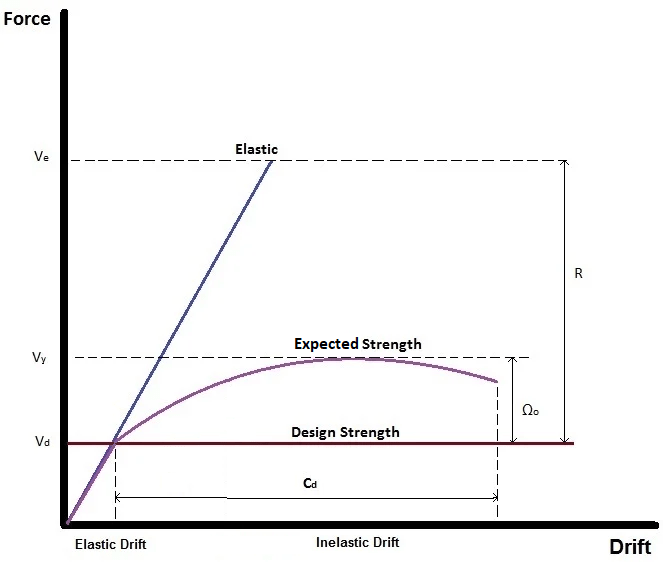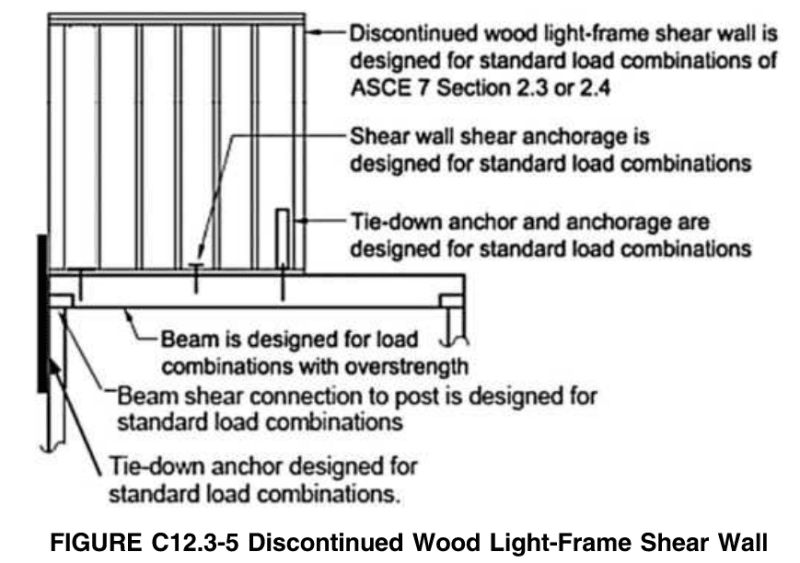kurichan
Civil/Environmental
- Apr 20, 2023
- 2
Hey all! I have been following Eng tips for a while but never actually posted, but I have a few questions I have been kind of stewing over and want to hear some of your thoughts (Sorry it is a bit long, I just want to be sure my reasoning is correct).
As I have taken classes in Seismic design there has seemed to be a bit of a discrepancy between the actual design theory, and what is industry standard with regards to overstrength. My understanding is that because the justification of using an R factor is based on the ductility of a material after yielding, that any element of the LFRS that is less ductile than the LFRS yielding element should be designed for overstrength. This is due to the yielding elements of an LFRS transferring more load than expected due to strain hardening of the material, conservation in design etc.
I have noticed that the R Value for wood shear walls is 6.5, is relatively high when compared to other LFRS (almost double that of an ordinary steel moment frame). This seems weird to me because a lot of other Wood based LFRS have very low R Values by comparison. Which leads me to think that it is not the wood but the nails themselves that are yielding in a shear wall. Because nails are super ductile, we are able to use a nice R Value of 6.5.
Building off of that, other elements of the LFRS that are more ductile than the nails (or would have the nails as their yielding element) would not need to have overstrength applied to them. For example a CS16 strap, HDU hold down (the device itself), A35 angle. Whereas any element of the LFRS that are not ductile like the nails should be designed with an overstrength factor. Examples of this would be an actual anchor into concrete (for an HDU or sill plate anchorage), a drag truss, a beam to which a hold down is strapped (along with the beam supports) etc. Is this reasoning correct?
main things that bugs me that seems to be “industry standard” is the often times overstrength is not applied to HDU anchors (like an SSTB bolt, cast in place rod, or epoxied anchor). Because of the nature of R factors and Overstrength it would seem that by not applying an overstrength factor we would be making the yielding element of our LFRS the brittle concrete. Which kind of undoes the while R factor thing.
I have heard people say that as long as our concrete anchor capacity is greater than the hold down capacity that we would be fine due to the hold down yielding before the concrete…which makes sense, my only concern for this would be that part the purpose of an overstrength factor is to account for strain hardening in the system. If the Hold down yields before the concrete…but then has strain hardening occur enough to increase the capacity to be greater than the concrete anchor, then the concrete anchor would be taking more load than it was designed for…thus causing a brittle element of our LFRS to control. This seems very wrong to me. I have also been told that Simpson accounts for this when reporting strength values for SSTB anchors, SHTD straps, PABs etc…is there any actual documentation for this though?
So…I guess my questions boil down to these two
1. Is it a safe assumption to say that most metallic connectors (like CS16 straps, HDUs, A35s, LTP4s, etc) are more ductile than a wood shear wall (or their yielding element is the nails) and thus do not need overstrength applied. (This would apply to FTAO straps…connecting a drag strut to the system via CS16 straps or LTP4/A35 plates, strapping over a cut in the top plate, etc).
2. Should we be designing concrete anchors in a shear wall system for a full overstrength factor? Or is there some justification to get around that?
As I have taken classes in Seismic design there has seemed to be a bit of a discrepancy between the actual design theory, and what is industry standard with regards to overstrength. My understanding is that because the justification of using an R factor is based on the ductility of a material after yielding, that any element of the LFRS that is less ductile than the LFRS yielding element should be designed for overstrength. This is due to the yielding elements of an LFRS transferring more load than expected due to strain hardening of the material, conservation in design etc.
I have noticed that the R Value for wood shear walls is 6.5, is relatively high when compared to other LFRS (almost double that of an ordinary steel moment frame). This seems weird to me because a lot of other Wood based LFRS have very low R Values by comparison. Which leads me to think that it is not the wood but the nails themselves that are yielding in a shear wall. Because nails are super ductile, we are able to use a nice R Value of 6.5.
Building off of that, other elements of the LFRS that are more ductile than the nails (or would have the nails as their yielding element) would not need to have overstrength applied to them. For example a CS16 strap, HDU hold down (the device itself), A35 angle. Whereas any element of the LFRS that are not ductile like the nails should be designed with an overstrength factor. Examples of this would be an actual anchor into concrete (for an HDU or sill plate anchorage), a drag truss, a beam to which a hold down is strapped (along with the beam supports) etc. Is this reasoning correct?
main things that bugs me that seems to be “industry standard” is the often times overstrength is not applied to HDU anchors (like an SSTB bolt, cast in place rod, or epoxied anchor). Because of the nature of R factors and Overstrength it would seem that by not applying an overstrength factor we would be making the yielding element of our LFRS the brittle concrete. Which kind of undoes the while R factor thing.
I have heard people say that as long as our concrete anchor capacity is greater than the hold down capacity that we would be fine due to the hold down yielding before the concrete…which makes sense, my only concern for this would be that part the purpose of an overstrength factor is to account for strain hardening in the system. If the Hold down yields before the concrete…but then has strain hardening occur enough to increase the capacity to be greater than the concrete anchor, then the concrete anchor would be taking more load than it was designed for…thus causing a brittle element of our LFRS to control. This seems very wrong to me. I have also been told that Simpson accounts for this when reporting strength values for SSTB anchors, SHTD straps, PABs etc…is there any actual documentation for this though?
So…I guess my questions boil down to these two
1. Is it a safe assumption to say that most metallic connectors (like CS16 straps, HDUs, A35s, LTP4s, etc) are more ductile than a wood shear wall (or their yielding element is the nails) and thus do not need overstrength applied. (This would apply to FTAO straps…connecting a drag strut to the system via CS16 straps or LTP4/A35 plates, strapping over a cut in the top plate, etc).
2. Should we be designing concrete anchors in a shear wall system for a full overstrength factor? Or is there some justification to get around that?


